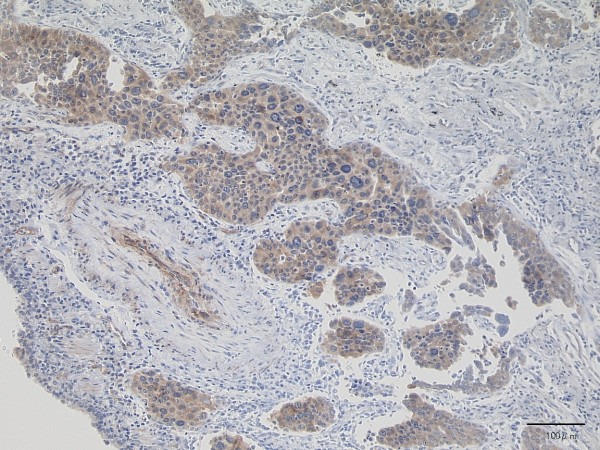Paraneoplastic syndromes are a heterogeneous group of disorders caused by an abnormal immune response to a neoplasm. The substances produced are not due to the direct effect of the tumor Tumor Inflammation, such as metastasis Metastasis The transfer of a neoplasm from one organ or part of the body to another remote from the primary site. Grading, Staging, and Metastasis, mass Mass Three-dimensional lesion that occupies a space within the breast Imaging of the Breast effect, or invasion. Antibodies Antibodies Immunoglobulins (Igs), also known as antibodies, are glycoprotein molecules produced by plasma cells that act in immune responses by recognizing and binding particular antigens. The various Ig classes are IgG (the most abundant), IgM, IgE, IgD, and IgA, which differ in their biologic features, structure, target specificity, and distribution. Immunoglobulins: Types and Functions, hormones Hormones Hormones are messenger molecules that are synthesized in one part of the body and move through the bloodstream to exert specific regulatory effects on another part of the body. Hormones play critical roles in coordinating cellular activities throughout the body in response to the constant changes in both the internal and external environments. Hormones: Overview and Types, cytokines Cytokines Non-antibody proteins secreted by inflammatory leukocytes and some non-leukocytic cells, that act as intercellular mediators. They differ from classical hormones in that they are produced by a number of tissue or cell types rather than by specialized glands. They generally act locally in a paracrine or autocrine rather than endocrine manner. Adaptive Immune Response, and other substances are generated and affect multiple organ systems. About 10% of cases of cancer are affected by paraneoplastic syndromes. The common cancers that present with paraneoplastic syndromes include cancer of the lung, breast, ovaries Ovaries Ovaries are the paired gonads of the female reproductive system that contain haploid gametes known as oocytes. The ovaries are located intraperitoneally in the pelvis, just posterior to the broad ligament, and are connected to the pelvic sidewall and to the uterus by ligaments. These organs function to secrete hormones (estrogen and progesterone) and to produce the female germ cells (oocytes). Ovaries: Anatomy, kidney, liver Liver The liver is the largest gland in the human body. The liver is found in the superior right quadrant of the abdomen and weighs approximately 1.5 kilograms. Its main functions are detoxification, metabolism, nutrient storage (e.g., iron and vitamins), synthesis of coagulation factors, formation of bile, filtration, and storage of blood. Liver: Anatomy, and stomach Stomach The stomach is a muscular sac in the upper left portion of the abdomen that plays a critical role in digestion. The stomach develops from the foregut and connects the esophagus with the duodenum. Structurally, the stomach is C-shaped and forms a greater and lesser curvature and is divided grossly into regions: the cardia, fundus, body, and pylorus. Stomach: Anatomy and lymphomas.
Last updated: Dec 15, 2025
Paraneoplastic syndromes are clinical syndromes that arise from an immune response to a neoplasm, producing substances that are not a direct effect of the tumor Tumor Inflammation, such as metastasis Metastasis The transfer of a neoplasm from one organ or part of the body to another remote from the primary site. Grading, Staging, and Metastasis, mass Mass Three-dimensional lesion that occupies a space within the breast Imaging of the Breast effect, or invasion of the tumor Tumor Inflammation.
There are 2 primary mechanisms:
| Clinical syndrome | Associated neoplasia | Pathogenesis |
|---|---|---|
| Cushing syndrome |
|
ACTH or ACTH-like substance production |
| SIADH SIADH Syndrome of inappropriate antidiuretic hormone secretion (SIADH) is a disorder of impaired water excretion due to the inability to suppress the secretion of antidiuretic hormone (ADH). SIADH is characterized by impaired water excretion leading to dilutional hyponatremia, which is mainly asymptomatic but may cause neurologic symptoms. S Syndrome of Inappropriate Antidiuretic Hormone Secretion (SIADH) |
|
Antidiuretic hormone Antidiuretic hormone Antidiuretic hormones released by the neurohypophysis of all vertebrates (structure varies with species) to regulate water balance and osmolarity. In general, vasopressin is a nonapeptide consisting of a six-amino-acid ring with a cysteine 1 to cysteine 6 disulfide bridge or an octapeptide containing a cystine. All mammals have arginine vasopressin except the pig with a lysine at position 8. Vasopressin, a vasoconstrictor, acts on the kidney collecting ducts to increase water reabsorption, increase blood volume and blood pressure. Hypernatremia (ADH) or vasopressin production |
| Hypercalcemia Hypercalcemia Hypercalcemia (serum calcium > 10.5 mg/dL) can result from various conditions, the majority of which are due to hyperparathyroidism and malignancy. Other causes include disorders leading to vitamin D elevation, granulomatous diseases, and the use of certain pharmacological agents. Symptoms vary depending on calcium levels and the onset of hypercalcemia. Hypercalcemia |
|
Parathyroid Parathyroid The parathyroid glands are 2 pairs of small endocrine glands found in close proximity to the thyroid gland. The superior parathyroid glands are lodged within the parenchyma of the upper poles of the right and left thyroid lobes; the inferior parathyroid glands are close to the inferior tips or poles of the lobes. Parathyroid Glands: Anatomy hormone–related hormone ( PTHrP PTHrP Hypercalcemia) |
| Hypoglycemia Hypoglycemia Hypoglycemia is an emergency condition defined as a serum glucose level ≤ 70 mg/dL (≤ 3.9 mmol/L) in diabetic patients. In nondiabetic patients, there is no specific or defined limit for normal serum glucose levels, and hypoglycemia is defined mainly by its clinical features. Hypoglycemia |
|
Insulin Insulin Insulin is a peptide hormone that is produced by the beta cells of the pancreas. Insulin plays a role in metabolic functions such as glucose uptake, glycolysis, glycogenesis, lipogenesis, and protein synthesis. Exogenous insulin may be needed for individuals with diabetes mellitus, in whom there is a deficiency in endogenous insulin or increased insulin resistance. Insulin or insulin-like substance |
| Clinical syndrome | Associated neoplasia | Pathogenesis |
|---|---|---|
| Lambert-Eaton myasthenic syndrome Lambert-Eaton Myasthenic Syndrome Lambert-Eaton myasthenic syndrome (LEMS) is an autoimmune disorder affecting the neuromuscular junction and has a strong association with small cell lung carcinoma. Lambert-Eaton myasthenic syndrome affects the voltage-gated calcium channels at the presynaptic membrane. Lambert-Eaton Myasthenic Syndrome | SCLC | Autoantibodies Autoantibodies Antibodies that react with self-antigens (autoantigens) of the organism that produced them. Blotting Techniques to presynaptic Ca CA Condylomata acuminata are a clinical manifestation of genital HPV infection. Condylomata acuminata are described as raised, pearly, flesh-colored, papular, cauliflower-like lesions seen in the anogenital region that may cause itching, pain, or bleeding. Condylomata Acuminata (Genital Warts)2+ channels Channels The Cell: Cell Membrane (anti–voltage-gated calcium Calcium A basic element found in nearly all tissues. It is a member of the alkaline earth family of metals with the atomic symbol ca, atomic number 20, and atomic weight 40. Calcium is the most abundant mineral in the body and combines with phosphorus to form calcium phosphate in the bones and teeth. It is essential for the normal functioning of nerves and muscles and plays a role in blood coagulation (as factor IV) and in many enzymatic processes. Electrolytes channel) |
| Myasthenia gravis Myasthenia Gravis Myasthenia gravis (MG) is an autoimmune neuromuscular disorder characterized by weakness and fatigability of skeletal muscles caused by dysfunction/destruction of acetylcholine receptors at the neuromuscular junction. MG presents with fatigue, ptosis, diplopia, dysphagia, respiratory difficulties, and progressive weakness in the limbs, leading to difficulty in movement. Myasthenia Gravis |
|
Anti-AChR antibody |
| Paraneoplastic cerebellar degeneration |
|
Antibodies Antibodies Immunoglobulins (Igs), also known as antibodies, are glycoprotein molecules produced by plasma cells that act in immune responses by recognizing and binding particular antigens. The various Ig classes are IgG (the most abundant), IgM, IgE, IgD, and IgA, which differ in their biologic features, structure, target specificity, and distribution. Immunoglobulins: Types and Functions against antigens in cerebellar Purkinje cells Purkinje cells The output neurons of the cerebellar cortex. Cerebellum: Anatomy (anti-Purkinje cell antibody) |
| Paraneoplastic encephalitis Encephalitis Encephalitis is inflammation of the brain parenchyma caused by an infection, usually viral. Encephalitis may present with mild symptoms such as headache, fever, fatigue, and muscle and joint pain or with severe symptoms such as seizures, altered consciousness, and paralysis. Encephalitis/encephalomyelitis (e.g., limbic encephalitis Encephalitis Encephalitis is inflammation of the brain parenchyma caused by an infection, usually viral. Encephalitis may present with mild symptoms such as headache, fever, fatigue, and muscle and joint pain or with severe symptoms such as seizures, altered consciousness, and paralysis. Encephalitis) |
|
Anti-Hu or antineuronal nuclear antibody (ANNA)-1 |
| Clinical syndrome | Associated neoplasia | Pathogenesis |
|---|---|---|
| Hypercoagulable Hypercoagulable Hypercoagulable states (also referred to as thrombophilias) are a group of hematologic diseases defined by an increased risk of clot formation (i.e., thrombosis) due to either an increase in procoagulants, a decrease in anticoagulants, or a decrease in fibrinolysis. Hypercoagulable States state or venous thrombosis Venous thrombosis The formation or presence of a blood clot (thrombus) within a vein. Budd-Chiari Syndrome ( Trousseau syndrome Trousseau syndrome Exocrine Pancreatic Cancer) |
|
Mucin release that activates clotting factors |
| Nonbacterial thrombotic endocarditis Thrombotic endocarditis Endocarditis ( sterile Sterile Basic Procedures thrombi) | Mucin-secreting adenocarcinoma | Thromboplastin-like substance ( hypercoagulable Hypercoagulable Hypercoagulable states (also referred to as thrombophilias) are a group of hematologic diseases defined by an increased risk of clot formation (i.e., thrombosis) due to either an increase in procoagulants, a decrease in anticoagulants, or a decrease in fibrinolysis. Hypercoagulable States state) |
| Polycythemia Polycythemia An increase in the total red cell mass of the blood. Renal Cell Carcinoma |
|
Erythropoietin Erythropoietin Glycoprotein hormone, secreted chiefly by the kidney in the adult and the liver in the fetus, that acts on erythroid stem cells of the bone marrow to stimulate proliferation and differentiation. Erythrocytes: Histology production |
| DIC DIC Disseminated intravascular coagulation (DIC) is a condition characterized by systemic bodywide activation of the coagulation cascade. This cascade results in both widespread microvascular thrombi contributing to multiple organ dysfunction and consumption of clotting factors and platelets, leading to hemorrhage. Disseminated Intravascular Coagulation |
|
Tumor Tumor Inflammation products that activate clotting |
| Clinical syndrome | Associated neoplasia | Pathogenesis |
|---|---|---|
| Acanthosis nigricans Acanthosis nigricans A circumscribed melanosis consisting of a brown-pigmented, velvety verrucosity or fine papillomatosis appearing in the axillae and other body folds. It occurs in association with endocrine disorders, underlying malignancy, administration of certain drugs, or as in inherited disorder. Diabetes Mellitus |
|
Secretion Secretion Coagulation Studies of epidermal growth factor |
| Leser-Trélat sign | GI adenocarcinomas | Hypersensitivity to growth factor |
| Dermatomyositis |
|
Immunologic response to proteins Proteins Linear polypeptides that are synthesized on ribosomes and may be further modified, crosslinked, cleaved, or assembled into complex proteins with several subunits. The specific sequence of amino acids determines the shape the polypeptide will take, during protein folding, and the function of the protein. Energy Homeostasis expressed by the tumor Tumor Inflammation; antibodies Antibodies Immunoglobulins (Igs), also known as antibodies, are glycoprotein molecules produced by plasma cells that act in immune responses by recognizing and binding particular antigens. The various Ig classes are IgG (the most abundant), IgM, IgE, IgD, and IgA, which differ in their biologic features, structure, target specificity, and distribution. Immunoglobulins: Types and Functions deposit where skin Skin The skin, also referred to as the integumentary system, is the largest organ of the body. The skin is primarily composed of the epidermis (outer layer) and dermis (deep layer). The epidermis is primarily composed of keratinocytes that undergo rapid turnover, while the dermis contains dense layers of connective tissue. Skin: Structure and Functions and muscle antigens are found |
| Necrolytic migratory erythema Erythema Redness of the skin produced by congestion of the capillaries. This condition may result from a variety of disease processes. Chalazion | Glucagonoma Glucagonoma A glucagonoma is a glucagon-secreting neuroendocrine tumor that originates from the β-cells in the pancreatic islets. Most glucagonomas are malignant, and many of them are part of the autosomal dominant condition known as multiple endocrine neoplasia syndrome type 1 (MEN 1). Elevated levels of glucagon lead to increased gluconeogenesis and glycogenolysis. Glucagonoma | Unknown |
| Sweet syndrome Sweet syndrome Condition characterized by large, rapidly extending, erythematous, tender plaques on the upper body usually accompanied by fever and dermal infiltration of neutrophilic leukocytes. It occurs mostly in middle-aged women, is often preceded by an upper respiratory infection, and clinically resembles erythema multiforme. Sweet syndrome is associated with leukemia. Hematopoietic Growth Factors |
|
Immune reaction to tumor Tumor Inflammation(s) and other antigens |
| Clinical syndrome | Associated neoplasia | Pathogenesis |
|---|---|---|
| Nephrotic syndrome Nephrotic syndrome Nephrotic syndrome is characterized by severe proteinuria, hypoalbuminemia, and peripheral edema. In contrast, the nephritic syndromes present with hematuria, variable loss of renal function, and hypertension, although there is sometimes overlap of > 1 glomerular disease in the same individual. Nephrotic Syndrome (membranous nephropathy) |
|
Tumor Tumor Inflammation antigen Antigen Substances that are recognized by the immune system and induce an immune reaction. Vaccination, immune complex deposition |
| Hypertrophic osteoarthropathy and fingers clubbing Clubbing Cardiovascular Examination | Lung cancer Lung cancer Lung cancer is the malignant transformation of lung tissue and the leading cause of cancer-related deaths. The majority of cases are associated with long-term smoking. The disease is generally classified histologically as either small cell lung cancer or non-small cell lung cancer. Symptoms include cough, dyspnea, weight loss, and chest discomfort. Lung Cancer | Fibrovascular proliferation |

Features of Cushing syndrome:

Moon facies in Cushing syndrome:
Classic finding caused by hypercortisolism

Buffalo hump in Cushing syndrome:
Classic finding caused by hypercortisolism

Hyperpigmentation caused by paraneoplastic Cushing syndrome
Image: “Fig1: Detail of the patient’s anonymized face showing moon face, hyperpigmentation, and hirsutism” by V. B. Weeda et al. License: CC BY 4.0
Lambert-Eaton myasthenic syndrome caused by lung cancer:
Chest CT scan showing a solid mass with spiculation

Lambert-Eaton myasthenic syndrome caused by lung cancer:
Histology of the specimen shows cancer cells, which came back positive for P/Q-type voltage-gated calcium channel on immunohistochemistry

Trousseau syndrome:
Thrombophlebitis migrans in a man with pancreatic adenocarcinoma
Tender erythematous rash on the medial aspect of the right forearm and left lower limb

Vegetations of the aortic valve at autopsy:
a: The macroscopic appearance of the aortic valve shows 2 vegetations of 4 mm and 5 mm in diameter.
b: Histologic evaluation shows that the vegetations consist of fibrin without bacterial colonies, consistent with noninfective endocarditis.

Acanthosis nigricans:
Dark discoloration that usually develops in body folds or creases, here affecting the right axilla. Skin becomes thick owing to hyperkeratosis and may appear velvety.

Leser-Trélat sign:
Seborrheic keratoses on the back of the hand that appeared and increased in size in a short period

Dermatomyositis:
Clinical features of dermatomyositis include:
(a): Heliotrope erythema
(b): Palmar erythema
(c): Periungual erythema
(d): Flagellate erythema

Necrolytic migratory erythema:
A: Extremely erythematous skin eruptions on the pretibial area
B: Biopsy showing a zone of necrolysis and vacuolated keratinocytes

Sweet syndrome: painful, erythematous, pseudovascular plaques of acute febrile neutrophilic dermatosis
a: Erythematous plaque on the left shoulder
b: Nodular lesion on the arm
c: Erythematous plaque on a finger

Hypertrophic osteoarthropathy:
A: Large right hand with edematous swelling
B: Periungual erythema and clubbing